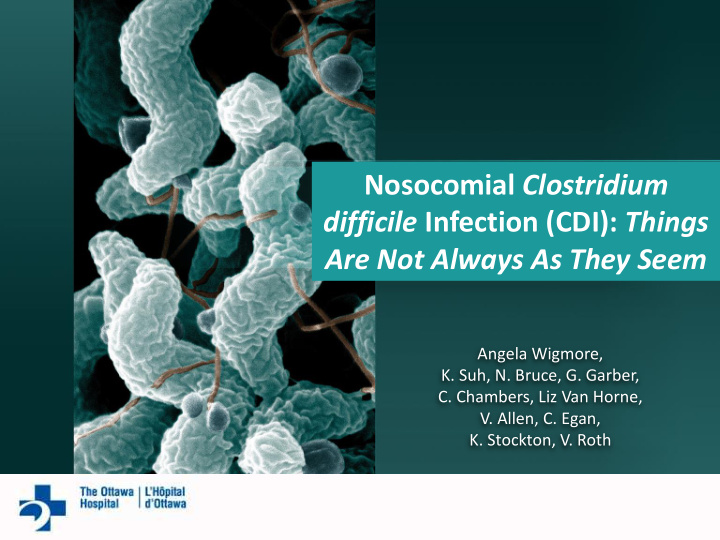



Nosocomial Clostridium difficile Infection (CDI): Things Are Not Always As They Seem Angela Wigmore, K. Suh, N. Bruce, G. Garber, C. Chambers, Liz Van Horne, V. Allen, C. Egan, K. Stockton, V. Roth
Disclosure • None of the authors on this presentation have anything to disclose
Clostridium difficile • Clostridium difficile is an anaerobic gram positive spore forming bacterium • It can cause a severe inflammatory colonic disease with a high morbidity and mortality • Most commonly associated with health care, occurring in hospitals and other health care facilities
Setting • The Ottawa Hospital (TOH): A multi site tertiary care facility with 1,200 beds • Most acute inpatient care is provided at 2 sites Civic
Background • CNISP CDI rates were stable between 1997- 2007 (0.66 and 0.73 per 1000 patient days, respectively)* • Healthcare – associated CDI is frequent and of increasing severity • CDI attributable mortality increased from 1.5% in 1997 to 5.3% in 2011 per 100 HA-CDI cases* * Public Health Agency of Canada, CNISP, Clostridium difficile Associated Disease (CDAD) Surveillance
Issue • 2012-2013 we experienced several prolonged outbreaks on our in patient units despite reinforcement of: -routine practises -prompt isolation of symptomatic patient -enhanced environmental cleaning with bleach -implementation of bedpan liner waste management transmission persisted
Issue Continued • In spite the implementation of these measures as well as the increase in resources and energy the outbreaks were not terminated • Several units continued to have an increase in nosocomial cases • Public Health Ontario was asked to conduct a review
Definition • Outbreak was defined as 3 or more geographically clustered cases of laboratory confirmed HA-CDI on one w/u within 7 day or 5 cases within 4 weeks • Healthcare associated CDI was defined as onset of symptoms >72 hours after admission or symptoms present on admission with a previous admission in the preceding 8 weeks
Investigation • Public Health Laboratory performed molecular typing of outbreak isolates • Methodology used was pulse-field gel electrophoresis (PFGE) • 41 isolates from 9 different outbreaks involving 48 patients (~3-9/outbreak) were typed
Floor Plan of An Outbreak Unit B CDI H NAP 4 CDI V CDI E CDI CDI F G CDI NAP 1 CDI CDI NAP11 L CDI M
PFGE Typing Different Same *Provided by Marina Lombos, Public Health Laboratory, Toronto, Ontario
Results • NAP-1 strain accounted for 39% of all isolates but was the predominant strain in only one outbreak • 16 different PFGE patterns were identified • A median of 3 PFGE patterns was identified in each outbreak (range 2-6) • Findings suggested that isolates from our outbreaks at TOH were polyclonal
Outbreak Typing Results No. No. samples No. unique Predominant Campus Unit patients typed strains Strain A 5 4 2 none B* 12 9 9 none General C* 9 8 6 none D 9 8 5 none E 3 2 2 none Civic F* 10 10 3 NAP1 TOTAL 48 41 16 NAP1 * 2 outbreaks on each of these units
Lessons Learned • Things are not always as they seem. HA cases that appear to be linked were caused by different strains of Clostridium difficile • In spite of our findings basic infection prevention measures remain the cornerstone in reducing transmission of Clostridium difficile
Conclusion • Prevention strategies need to shift with a greater focus on appropriate antimicrobial use • Typing did not produce the results we expected leaving many questions still unanswered • The epidemiology of CDI in the community also deserves further study.
Acknowledgements I would also like to thank and recognize the following individuals: • Dr Gary Garber • Cathy Egan • Liz Van Horne • Vanessa Allen • Marina Lombos
Recommend
More recommend